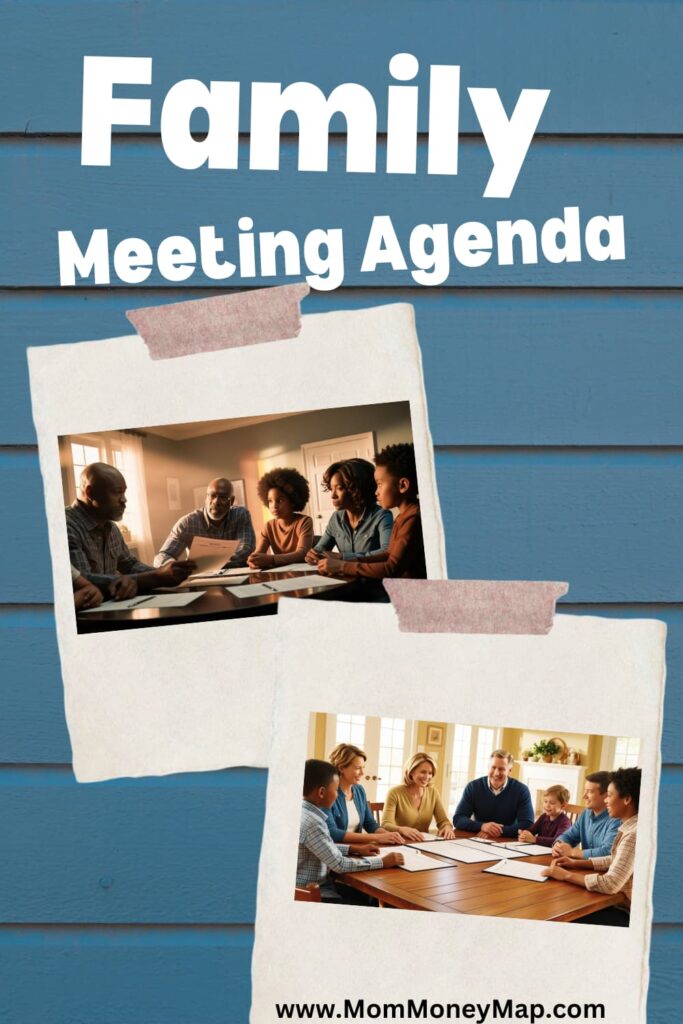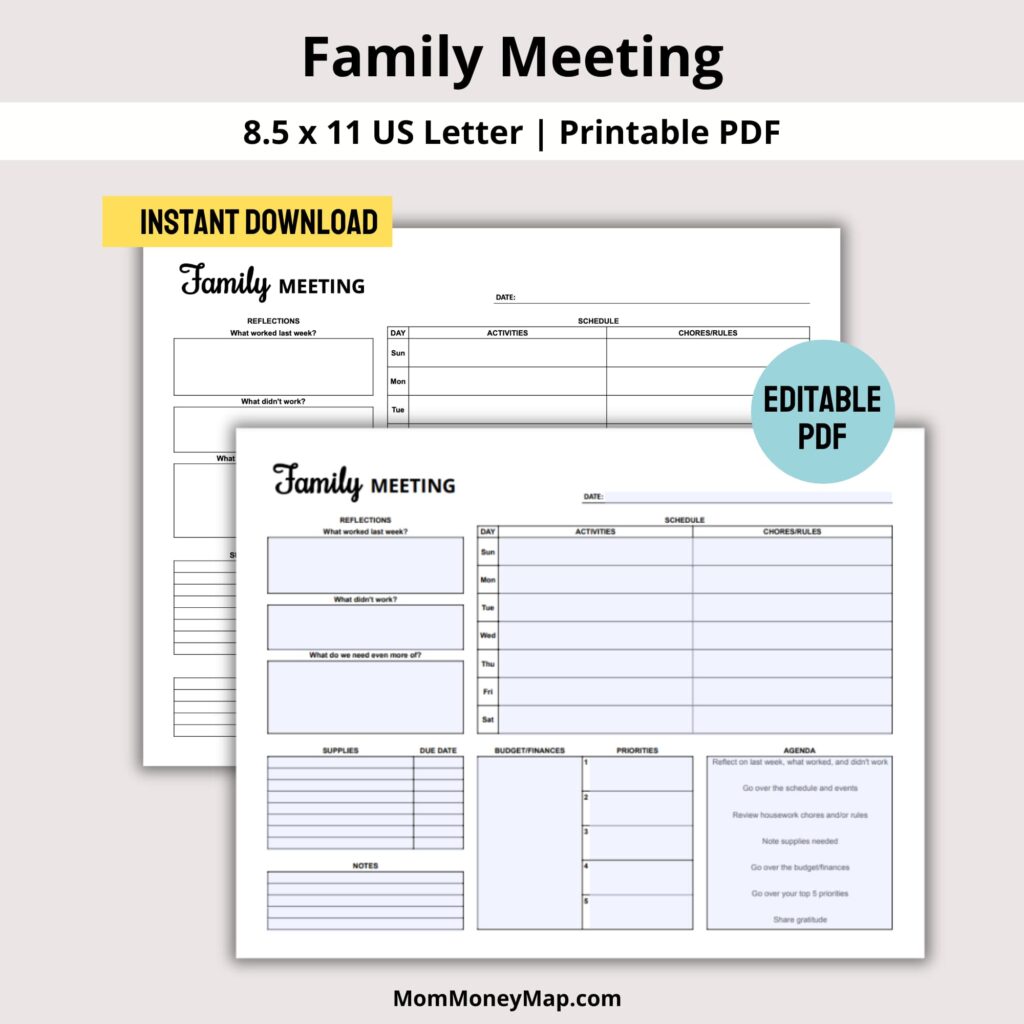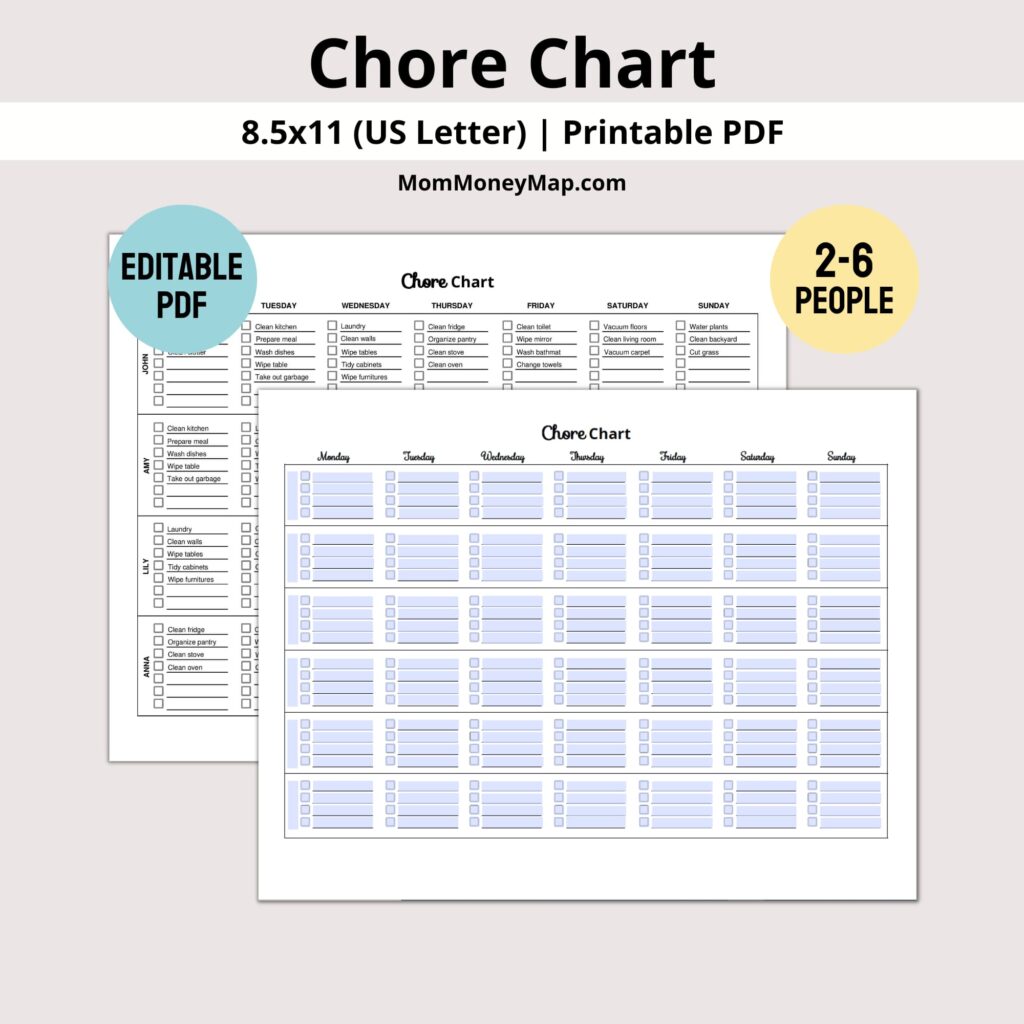Family Meeting Agenda
Want to learn how to put together a killer family meeting agenda?
Imagine this: instead of the usual chaos with everyone going their separate ways, barely crossing paths, what if your family functioned like a well-oiled team, perfectly in sync?

Sounds great, right!?
But is having a family meeting too structured?
Have you suggested it to your family members and been met with stares that imply you’re losing it or dreaming?
I mean, you’re already juggling full-time jobs, school, social events, housework, parenting, and a million other things; is the idea of a family meeting too audacious?
The short answer – no way!
In this post, we’ll cover:
– The purpose of family meetings
– Benefits of regular family meetings
– How often you should have a family meeting
– How to have an effective family meeting
– Preparing for the first-ever family meeting
– Committing to regular meetings
Of course, like any new habit, you might need help to get everyone on board.
But I want to empower you to be the captain of this ship, help your family see the good things that can come from spending this time together, and make this a special time.
Let’s start this post by discussing the purpose of family meetings.
Understanding this can help you avoid potential pitfalls that might turn your family off from regular meetings.
This post may contain affiliate links, meaning if you make a purchase, I may earn a small commission, at no cost to you. Please read the disclosure for more information.
Purpose of family meetings
Let’s be honest for a second—life is busy.
Between work, school, sports, and trying to remember if the cat has been fed (again), it’s a wonder we even see each other at all, let alone have a meaningful conversation with one another.
I have been guilty of not knowing what was going on at my husband’s job or forgetting about a school project I needed to help my daughter with because I have been so wrapped up in everything else.

And while this will happen now and again because we aren’t perfect, family meetings are an excellent remedy to this problem!
I like to think of it as our family’s secret weapon, a powerful tool to help us tackle the foes of miscommunication, forgotten chores, and the never-ending debate over what’s for dinner.
Now, I know the idea of gathering everyone in one room for a “meeting” might sound about as fun as watching paint dry.
But here’s the biggest lesson you can take away from reading this blog post – it’s not just about logistics; it’s about connection.
It’s about taking a moment to pause the craziness of life and actually check in with each other.
- How’s school going?
- What’s been on your mind lately?
- And, seriously, why are there socks on the living room floor again?
A family meeting is your chance to hit the reset button to make sure everyone’s not just surviving but thriving.
So, while it might seem like just another item on your to-do list, it’s so much more.
It’s the glue that holds your crazy, wonderful, messy family together.
7 benefits of regular family meetings
While having a family meeting is a great way to get in sync with each other, there are some additional benefits which are a nice cherry to throw on top!
1. Reinforce family values
A family meeting provides a chance to remind everyone of the family values and what it means to be a member of this family.
For example, you could use this opportunity to remind everyone about the value of sharing, picking up after ourselves, or being kind.

You could even get creative and reward one family member at each meeting for best demonstrating these values throughout the week.
2. Tackle important issues
When we get busy, it can start to feel like we need to tackle important issues by ourselves.
Anything from a homework assignment that your kids are struggling with to a problem your spouse has with the weekly grocery order they’re supposed to pick up, family meetings are a chance to bring these issues up and brainstorm solutions together.
As a child, I remember feeling like my parents or my sibling was busy with their own problems, so I would hide the challenges I was facing from them.
This is not something I ever want my daughter to experience, so I love that a family meeting creates an opportunity where she feels safe to share.
3. Plan a fun activity to do together
Not all family meetings need to be about serious topics!

You can also use this time to plan something fun, like a family outing, game night, or even a stay-at-home movie marathon.
It adds a little excitement to the routine, gives everyone something to look forward to, and helps to build a positive family culture!
4. Family goal setting
Setting goals as a family can be incredibly motivating.
Whether it’s saving up for a vacation, planning a home project, or improving communication, having a collective goal brings everyone together and gives you all something to work toward.
It’s also a perfect time to talk about individual goals and how your family can support you.

For example, if one of you wants to try a new food item, we can all brainstorm a recipe plan that supports that goal.
Or if someone wants to spend more time reading and less time watching TV, we can collectively set a new TV schedule.
Who knows, maybe you’ll all end up jumping on the same goal bandwagon and doing it together!
5. Develop family problem-solving skills
I’ve found that, as a parent, sometimes, the easiest way to teach something is to demonstrate it.
I love doing this with things like communication skills, effective listening, planning, and so on.
But one thing that is really unique about a family meeting is that it can teach your kids about family problem-solving skills.
When everyone contributes to finding solutions, it helps resolve issues and teaches valuable life skills like negotiation, compromise, and creative thinking.
It also shows the value of being a member of the family and teamwork – so it’s a win-win!
6. Strengthen the family bond
Regular family meetings are like a cozy blanket that wraps everyone up in togetherness.

It’s your time to laugh, share stories, and maybe even reveal who’s been taking the last of the ice cream.
Spoiler: it was probably Dad.
But in all seriousness, family meetings are a great way to strengthen your family bond.
7. Creates a family tradition
When you think of family traditions, you probably think about things like Taco Tuesdays and what you ate for supper on Christmas Eve.
But family traditions don’t always have to be about the fun things.
After all, being a strong family unit takes effort from everyone!
By making family meetings a regular thing, you’re starting a tradition that’s equal parts bonding and productive.
One day, your kids might even look back and say, “Remember when we used to have those meetings?”
And you can bet they’ll want to keep the tradition alive with their family someday!
There are so many positive things that can come from a family meeting!
So, by now, you’re all excited and ready to implement this plan!
But, before you run off to your family and announce this new plan to have family meetings, you should first establish how often you want to have family meetings.
How often should you have a family meeting?
Ah, the million-dollar question: how often should you gather the troops for a family meeting?
Well, there’s no one-size-fits-all answer here.
It really depends on your family’s rhythm and how much you all think you need to meet for this current season of life!
In other words, think about the family’s needs!
If your household is buzzing with activity and you’re juggling a million things at once (because, of course, you are), a weekly meeting is a great way to keep everyone on the same page.
But hey, if weekly meetings sound too ambitious (because, let’s be honest, life happens), bi-weekly or even monthly might be just right for you.
The key is consistency.
Whether it happens on Sunday evenings, every other Monday, or the first Friday of the month, pick a time that works for everyone and stick to it.
This way, it becomes a regular part of your routine—like Taco Tuesdays, but with fewer tortillas and more talking.
*Tip – if you can’t find time on the calendar that works for everyone’s schedule, you could also make it part of your family dinner. This works whether you eat together once a week or every single day.
How to have an effective family meeting
So, you’ve decided to give family meetings a shot, and everyone is on board – high five to you!
But now you’re probably wondering, how do you make sure these meetings are actually effective and don’t just turn into a chaotic free-for-all?
Here are my top tips for running a smooth, successful, and, dare I say, enjoyable family meeting!
1. Set ground rules (and stick to them)
Before diving into the nitty-gritty of your family meeting, laying down some ground rules is essential.

Having ground rules in place will ensure you get to reap the benefits of family meetings while also respecting every member of the family.
Start with basics like:
- One person talks at a time. No interrupting, no matter how much someone wants to jump in—everyone gets their turn to speak.
- Respect is non-negotiable. Disagreements will happen, and that’s okay! However, respect should always be the foundation of any discussion. No name-calling or blaming; keep it constructive.
- Keep it positive. Focus on solutions, not just pointing out problems. Encourage everyone to bring ideas to the table rather than just complaints.
- Confidentiality counts. What’s said in the family meeting stays in the family meeting. This helps create a safe space where everyone feels comfortable sharing.
By setting these ground rules from the start, you’ll ensure that your family meetings are a space where everyone feels heard, respected, and ready to work together.
Plus, it’s a great way to teach kids the importance of respectful communication—skills that will serve them well beyond the family meeting table.
2. Set an effective agenda (but keep it flexible)
Before you dive in, have a loose plan of what you want to cover.
It doesn’t have to be anything fancy—just a few bullet points on what needs to be discussed.
It could be chores, weekend plans, family finances, or who’s responsible for taking out the trash (again).
But feel free to let the conversation flow naturally.
The agenda is your guide, not a strict script.
I also recommend checking in with the whole family to see if there is anything they have any agenda items to add so that everyone feels included and heard.
Here’s an example of a family meeting agenda if you want to have a turn-key solution.
On a side note, I have this family chore chart that you can print out and include in your family agenda to help with chore planning.
3. Pick a leader (and rotate the role)
Every great meeting needs a leader to keep things on track.
Whether it’s you, your partner, or even one of the kids (seriously, they love the power and it’s good for them to learn to lead), pick someone to steer the ship.
And consider rotating the role each time so everyone gets a chance to lead—trust me, it’s a great way to boost confidence and keep things interesting.
4. Encourage everyone to speak up
The number one mistake I see my friends make when they first try a family meeting is that they only let the meeting leader speak.
But this strategy is a surefire way to squash open communication.

Remember, this is a family meeting, not a monologue.
Make sure everyone can share their thoughts and feelings, even the littlest voices.
You might be surprised at the wisdom that comes from your kids when they’re given the floor.
And remember, all opinions are valid—even if the opinion is that pizza should be a food group.
5. Focus on solutions, not problems
I mentioned this in the ground rules section, but it’s essential in a family meeting!
It’s easy to get bogged down in what’s not working when people are feeling frustrated.
But the real magic happens when you switch gears to problem-solving.
Instead of dwelling on who didn’t clean their room or who forgot to pick up the milk, brainstorm ways to make these things more manageable.
Solutions can sometimes be the most challenging part to focus on, so here are some ideas you can plan ahead of your first family meeting!
- Reward systems. (This can be helpful for new projects, chores, cooking, homework, etc. Do proceed cautiously when devising a rewards system. I’m on the fence about reward systems, especially for chores, because I think that if adults don’t get paid to do them, kids shouldn’t get paid either. I heard about this concept from this book, which talks about how to teach your child about money. I highly recommend reading it if you haven’t already.)
- Habit tracker. (This is great for personal care, homework, etc. This is my habit tracker spreadsheet that I love using because it has daily, weekly and category analytics! You can see the big picture immediately.)
- Shared family calendar – digital or physical. (Great for appointments, schedule sharing, etc. My husband and I use Google Calendar. I also recommend having a physical reminder for the kids on the fridge like this monthly calendar template that you can print and fill out with your upcoming important events like dentist appointments, birthday parties, etc.)
- Teaming up. (Great for large projects. It can feel daunting to tackle a large project head on by yourself, but if you break it into more smaller, more manageable tasks and then delegate it, you’ll complete that large project much more happily and quickly.)
- Rotational plans. (Great for meal plans, cleaning routines, etc. I have a few meal planning tools, but this meal prep planner printable and this meal planner spreadsheet with an automated grocery list are my go-tos right now. )
- Digital reminders. (Great for chores, cooking, to-do list items, etc. I set an alarm clock on my phone for everything from meetings to kid’s activites to clean up time to prepare for the bedtime routine.)
6. End on a positive note
No matter what’s been discussed, always wrap things up on a high.
This helps everyone leave the meeting on a good note!
You could share:
- Something each of you is looking forward to for the upcoming week.
- Compliments to one another.
- Things you’re grateful for that week.
- A funny joke you heard.
- An accomplishment from the week that you’re proud of.
7. Keep it short and sweet
Remember, attention spans can be short.
A good time to aim for each family meeting is around 20-30 minutes.
You want to cover all the important stuff without anyone getting restless.
And if things start to drag, wrap it up and save the rest for next time.
8. Follow up with one another
The meeting doesn’t end when everyone leaves the table – and you should gently remind everyone of that after the first few meetings.
The way I recommend doing this is:
- Make sure to follow up on any action items or decisions made.
- Assign problem-solving solutions to a specific person. (Such as setting up a family calendar or writing the meal plan down on the fridge.)
- Check-in during family meals.
Doing these things will help keep the momentum going and show that what was discussed truly matters.
With these tips in hand, you’re all set to run a successful family meeting that leaves everyone feeling heard, happy, and ready to take on the world—together!
Preparing for your first family meeting
So, you’re ready to kick off your first family meeting—exciting stuff!
You’ve got all the tips and strategies I’ve learned over the years of doing these in your pocket, so now it’s just time to get it done!
But I’ve got a couple of bonus tips before you leave to help you prepare for the first-ever family meeting and make it more fun for everyone!
- Have snacks and drinks ready! – Everyone loves to have a little snack to munch on while they’re talking and brainstorming solutions.
- Get everyone their own notepad. - Doing this makes everyone feel special. Plus, now they’ve got somewhere to write down their action items!
- Set up a reminder system. – For the first few times, you might need to give your family members a gentle reminder of the upcoming meeting. So, create a way to remind them so that they aren’t caught off guard.
- Create a cozy space. This isn’t a business meeting! Pick somewhere in the house where everyone can get comfy without too many distractions.
- Be ready with a prompt to end the meeting on a positive note! Earlier in the post, I shared some strategies to help you end each meeting on a positive note! Make sure you come to the meeting armed with that prompt!
Related Articles on this Family Meeting Agenda:
- Money Book for Kids That Teach Financial Literacy
- Best Board Games for 5 Year Olds
- How to Do Montessori on a Budget
Enjoyed this post?
It would be great if you could share it and follow me on Pinterest or Facebook.










